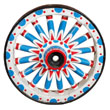Sells-Floto Elephant Tableau
By Joseph Bradbury
(1) The wagon was built in Denver quarters about 1905 for the Great Floto Shows, owned by Fred Bonfils and Harry Tammen, with Otto Floto also in on the deal. Bonfils and Tamen were the owners of the Denver Post newspaper and Otto Floto the sports editor. The show became known as the Sells-Floto Circus for the 1906 and following seasons. There is a chance that the actual carvings on the wagon were furnished by the Bode Wagon Works. My first photo of the wagon shows it as the No. 1 bandwagon on Sells-Floto taken in Mexico City on Dec. 2, 1906. It was pulled by a fourteen horse hitch. The wagon served as the No. 1 bandwagon through the years on Sells-Floto.
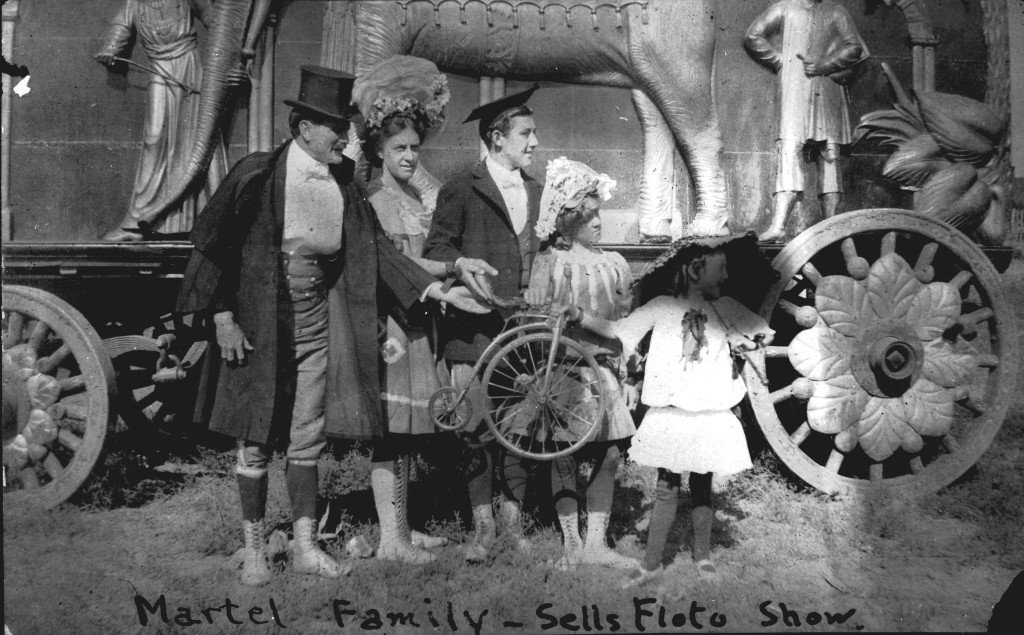 ( 1906 – Conover collection of circus images – this shows the wagon was originally a dark body ( red perhaps ) with all the carvings the same color ( gold perhaps )
( 1906 – Conover collection of circus images – this shows the wagon was originally a dark body ( red perhaps ) with all the carvings the same color ( gold perhaps )
In 1914 and 1915 the show was called Sells-Floto Circus and Buffalo Bill Wild West, and Buffalo Bill himself was with the show. The wagon was on the show on through the 1924 season and then no doubt was there also in 1925. All of the three American Circus Corporation units, Sells-Floto, Hagenbeck-Wallace, and John Robinson went out in 1925 intending not to parade, but in late May of that year the parade was revived. The Billboard claims that the shows went out prepared to parade if it was felt it was necessary for business reasons. With that we can assume the wagon was also there in 1925.
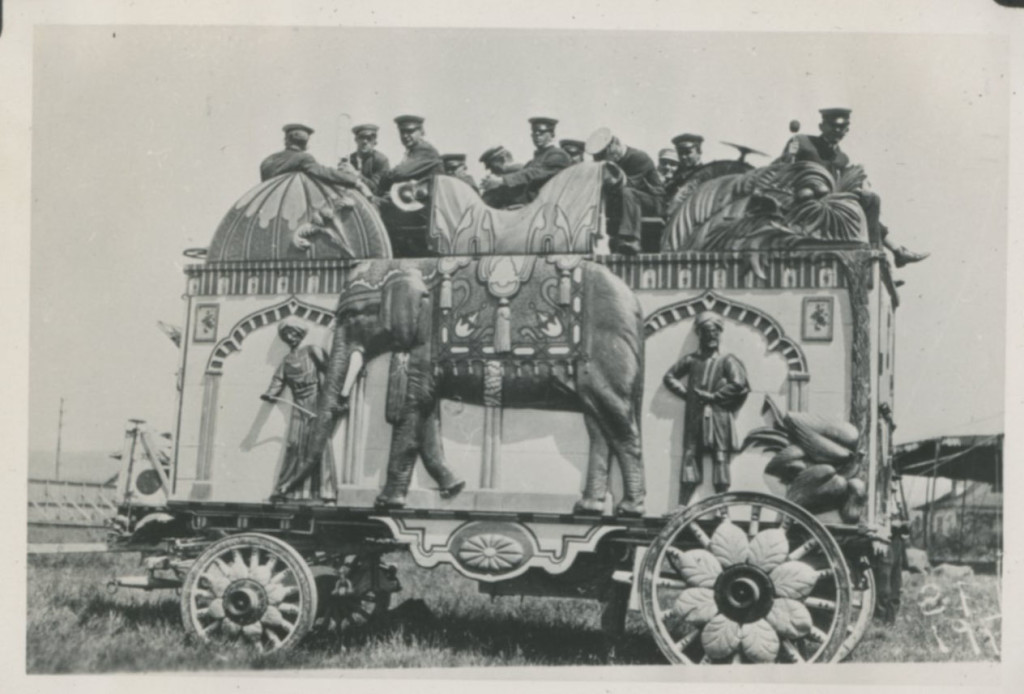 ( 1915 – Joseph Bradbury Album # 25 – photo # 56A – in Topeka, KS. – Jim McRoberts collection )
( 1915 – Joseph Bradbury Album # 25 – photo # 56A – in Topeka, KS. – Jim McRoberts collection )
In 1926 the parade on Sells-Floto was abandoned, but whether this wagon was parked at Peru quarters or was still taken on the road I am unable to state. It does not appear in any photos I have seen of Sells-Floto from 1926 through 1932 the last year Sells-Floto was on the road, but during that time other tableaus were carried on the road some seasons, for example in 1929 both the Buffalo tableau and the old India or Jardiner tab were on the show.
In 1933 the Elephant tableau appeared on the Hagenbeck-Wallace Circus now enlarged to 40 cars since Sells-Floto was not sent on the road. In 1933 manager Jess Adkins tried a few old time street parades to stimulate business and the Elephant tableau was used in those parades. The 1933 spot parades were so successful that in 1934 Hagenbeck-Wallace featured a daily street parade, one of the largest and best in history. The show was enlarged to 50 cars a move made necessary primarily to carry the added parade equipment. The Elephant tableau was used in the 1934 parade, although not as one of the principal bandwagons.
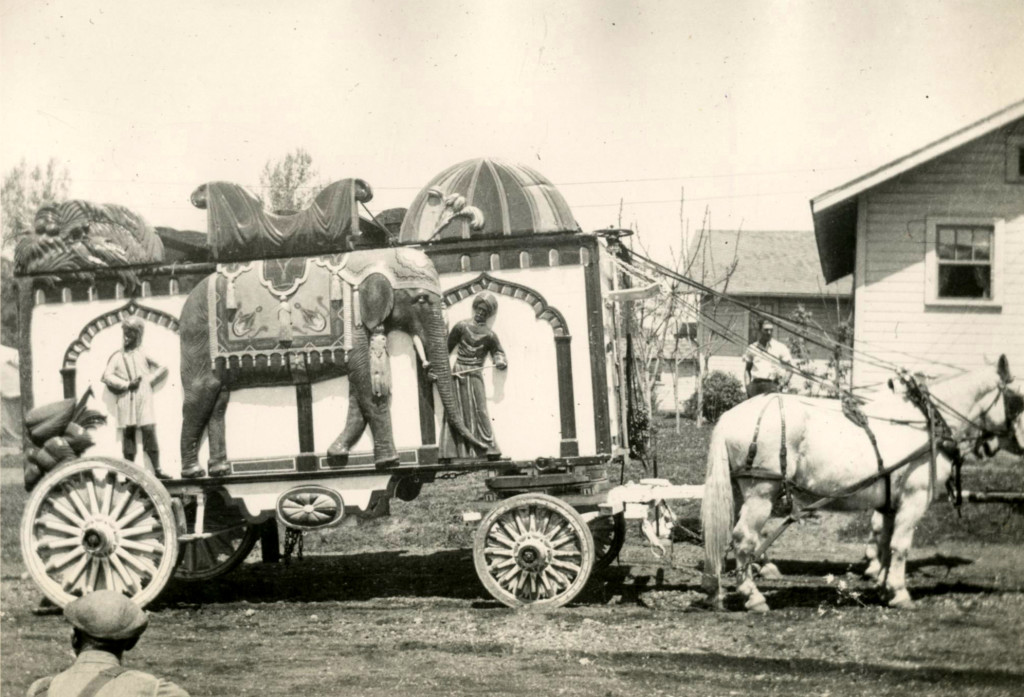 ( 1934 – Joseph Bradbury Album # 31 – photo # 46B – Hagenbeck-Wallace 1934 in Kokomo, IN. – George Piercy photo )
( 1934 – Joseph Bradbury Album # 31 – photo # 46B – Hagenbeck-Wallace 1934 in Kokomo, IN. – George Piercy photo )
In 1935 the show was cut down considerably and only a few parades were given and those in opposition stands only. The 1935 show was known as Hagenbeck-Wallace and Forepaugh-Sells Combined Circus, the latter title being tacked on to preserve the title from falling into public domain and also for tax purposes, so I’ve been told. There is a good chance the Elephant wagon was on the show in 1935 but I’ve yet to find it in any photos I’ve seen of that show.
In 1936 the Hagenbeck-Wallace show did not go on the road but remained in Peru quarters.
For 1937 season Ed Arlington and Frank Hatch leased the title and property and made a small fortune during the early weeks of the season before selling their interest to Howard Bary who continued to take the show on the road and do a good business all during that season. The Elephant tableau is supposed to have been taken on the road in 1937. The show did make a few parades in the early part of the season but cancelled them later.
In 1938 Hagenbeck-Wallace again went out under Bary’s management, but the Elephant wagon was left in Peru quarters. It remained there until 1944 when the Ringling interests sold the quarters. The wagon along with a few others who got repreived from the large wagon burnings that took place there and was shipped to winter quarters in Sarasota.
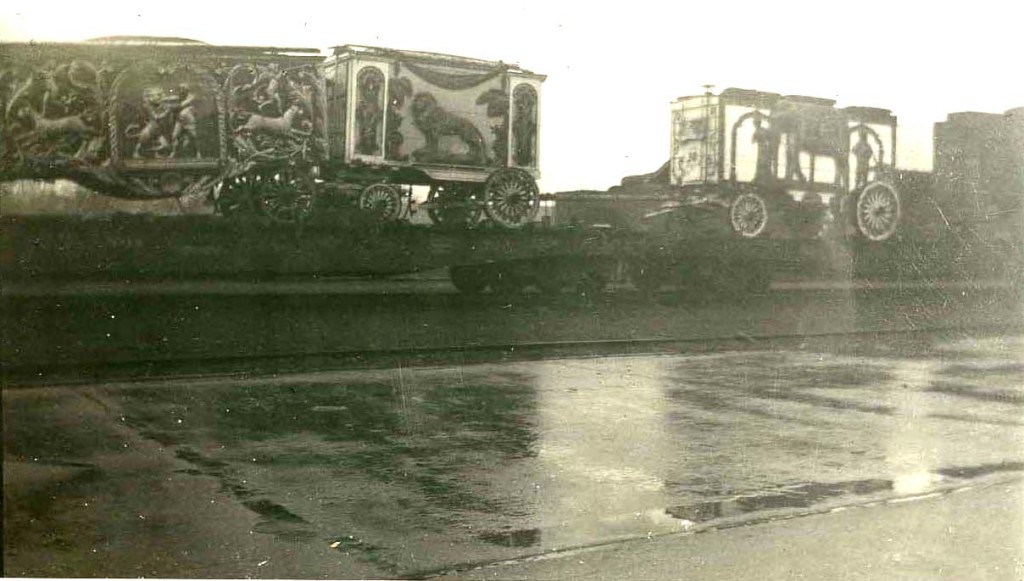 ( 1944 – Joseph Bradbury Album # 18 – photo # 56C – Peru Railyards – April, 4, 1944 – These wagons were saved from the 1941 wagon burnings. They are seen here loaded on system flats to be taken to the Ringling bros. and Barnum & Bailey Circus winter quarters in Sarasota, Florida )
( 1944 – Joseph Bradbury Album # 18 – photo # 56C – Peru Railyards – April, 4, 1944 – These wagons were saved from the 1941 wagon burnings. They are seen here loaded on system flats to be taken to the Ringling bros. and Barnum & Bailey Circus winter quarters in Sarasota, Florida )
The wagon remained in Sarasota rotting away in the sun and rain until late 1949. When I visited there in February 1949 the wagon was sitting out in the wagon graveyard down to the hubs in sand. A couple of guys were living in it, had knocked out one side and were hanging their wash out on a line. It was fast going to complete ruin, but fortunately John Sullivan of the Museum of the American Circus saw that the wagon was rescued and put in the museum to join several other old wagons that had ben placed there a year earlier. The Elephant wagon remained at the museum until December of 1955 when the Ringling management moved the wagons back to the winter quarters for a TV program. I assume the Elephant wagon went with the rest, although I don’t believe it was actually used in the TV show. Anyway, it is still in Sarasota and can be seen at the museum.
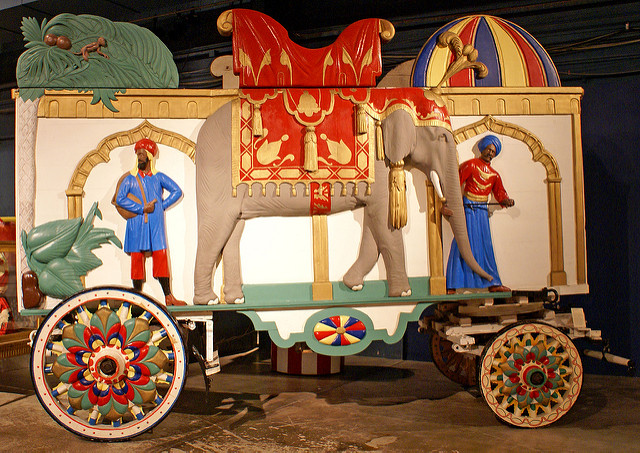 ( 2006 – Bob Cline photo )
( 2006 – Bob Cline photo )
The wagon can be seen in person at Ringling Museums in Sarasota, Florida
(1) Excerpts from Bandwagon, Vol. 1, No. 5 (Nov), 1957, p. 9.
If you have any questions or have more photographic evidence, feel free to contact us at circuswagons@gmail.com
